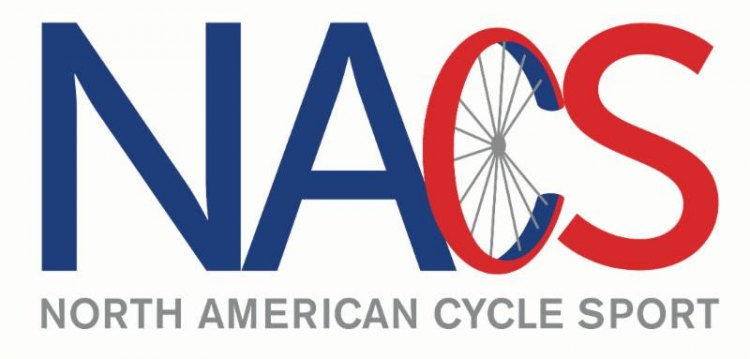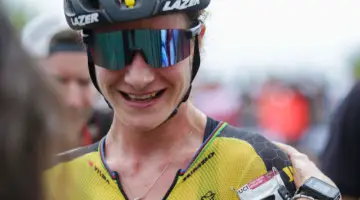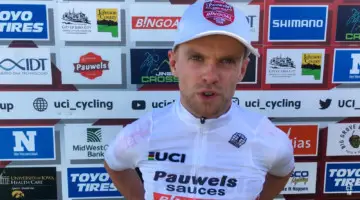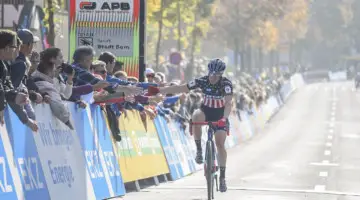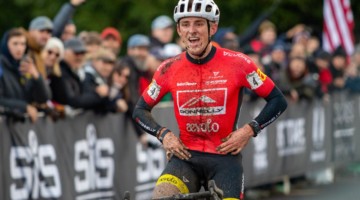Some time after our interview with USA Cycling (“USAC”) CEO Derek Bouchard-Hall, which was featured in issue 30, we sat down and spoke with Tod Manning, CEO of North American Cycle Sport (“NACS”) about that new cycling governing body, some of the reasons for the group’s creation and the goals it has for itself and cycling in general.
NACS joins not only USAC, but also the North American Bicycle Racing Association (“NABRA”), featured in issue 26. This though was our first chance to speak with the person in charge at NACS. And there was a good amount to discuss about their uphill battle to become a third major sanctioning body in bike racing.
Since the time of our initial interview, which is below, Manning and NACS have been working to grow their concept into a viable business that helps those wanting to enter the sport in either a promoter or racer role. We also spoke about recent changes with USAC and examined how NACS stacks up against NABRA for promoters.
Most recently, NACS announced that riders participating in NACS-sanctioned events can use a license from nearly any other governing body for a $5 USD surcharge, negating the need to purchase a secondary license. It’s worth noting that USAC revised its fees late last year, reducing the cost of the one-day license.
NACS has also finalized their per-rider insurance costs at $3.35 for competitive events and $2.10 for non-competitive events. More generally, Manning in a recent follow-up conversation told us that they’ve seen more responsiveness from USA Cycling when it comes to dealing with promoters and local associations, two target areas for NACS.
You can read part one of our conversation with Manning, below.
With reporting from Andrew Yee, assistance from Greg Evans, and additional follow-up by Daniel Curtin.
Cyclocross Magazine: How did this idea for NACS came about, how long have you guys have been working on it, and when did it officially launch?
Tod Manning: All of us here were operating independently with ideas of what could be and we were each getting frustrated with USA Cycling (“USAC”). I was trying to make changes and pointing out some fairly significant issues, and getting absolutely nowhere with [USAC with] that, and if anything going backwards.
There were two things that put me off the path of trying to work inside of USAC. One was insurance, and the fact that USAC removed officials from being covered by insurance, and we had been uncovered for approximately two years. This was announced to the national technical commission during a meeting in 2013. Everybody in the room was just shocked. Myself and another person on the national technical commission, we had been working for months trying to get answers to questions regarding the insurance for officials and had been stonewalled.
In response I basically said “I have a presentation to do on insurance, I’m going to recommend every official in the room stop officiating for USAC.” They quickly got us back into the insurance policy, they have since declared that there never was an announcement. We just wanted to see the policy, and they refused to do so.
What came out of all of this was a complete lack of trust in USAC when it came to the matter of insurance.
The other thing was Safe Sport. The very first case that they went after was an official because a member of their staff didn’t like the way that the official spoke to her at a race. When we got to the details of it, it was like, “you’ve got to be kidding me.” It was basically a witch-hunt, and the way the thing was handled, we ended up filing a complaint against USAC using their own rules. USAC hired attorneys, they spent a ton of money for something where all we wanted was for them to stop bullying officials and live by their own rules.
I’m a guy that’s done lots of investigations for USAC and used their rules and policies, and what they did was they kept changing the policy. I would write a brief and say, “according to your own policy,” and cite their rules. They would wait for a while and then they would get back to me and say, “we have no idea what you’re talking about, the policy doesn’t say that.” I would go online, and they had changed the policy. They did that so often that one of the attorneys actually resigned from the case.
You put that together with the insurance and with how monies were being handled, it was just so many things like that and it was enough is enough.
Steve Johnson’s take it or leave it attitude was directed at everybody. I started writing on that and just finding interest in what I thought were problems, and what people thought.
What ended up happening was a number of like-minded folks got together and we started thinking “What if, what can we do differently, how can we make this a better sport and and bring it back?” We looked at the way it could be and we moved forward.
CXM: Hearing your background story makes it sounds like most of the grievances and motivations for starting a new organization are related to officials and insurance as opposed to grassroots cycling development. Is that a fair assumption? Or is it just that those two issues were just the catalyst or the straw that broke the camel’s back?
TM: It was the catalyst. Being an official out there day in, day out over the weekends over the years, and seeing the mandates that officials have as representatives of USAC to collect monies and deal with the stuff that the riders and the promoters are dealing with, and I just didn’t like what I was seeing.
I was collecting big checks from guys [who] were just breaking even, and sending it off to USAC, and just looking around and thinking, “what’s coming back? What is coming back to these riders?”
And then I saw the form 990’s form USAC where they’re bragging about giving back $450,000 USD to local associations in membership rebates, and I was like “wait a second, that’s all the money that’s going out there?” As I started looking at where the money was going, I did not see support for grassroots racing.
I always had this funny idea in my head that all of this money was coming back to the local associations and to race promoters to help them put events on. When I started digging into it we were blown away at how little was coming back.
CXM: Is that just because there were much larger costs somewhere that you didn’t know about? Or is there wasted money in other channels of the sport or is there wasted money in too-high salaries and bureaucracy? Where did that money go?
TM: I don’t want to throw the adjectives on there, because it’s inflammatory for me to do so, and I don’t think it’s fair. Do I have opinions on it? Absolutely. USAC has a mandate from the US Olympic Committee that they have to meet, and it has to do with Elite-level riders and it has to do with developing the sport in the US. How they go about doing that is not my concern when it comes to the elite level. My concern is more about the grassroots level. How they [USAC] spend their money is up to them, but what I don’t want them to do is spend all of that money on the Elites and the infrastructure and the salaries at USAC, and not put a proportional amount back into grassroots.
CXM: One of the perceptions among our audience, myself included, is that over the years, cyclocross has been one of the fastest growing segments of the sport and that we’re typically active athletes who race twice a weekend for three months and we think that a disproportionate amount of our money ends up going towards Olympic disciplines of cycling. Would you say that’s accurate knowing what you know?
TM: I would say that’s accurate
CXM: My dream was that why don’t you just treat it like a silo; if money is coming in from cyclocross, give it back to the same discipline. That’s all I ever wanted but I don’t make those decisions. Because you’re starting a new organization, is it a possibility to model it that way?
NACS: I want to say yes. And here’s how I think about it. We are evolving as we speak. The membership model that we have posted on our site, it occurred to me is “wait a second, we are using an 18th or 19th century model for how we’re doing business.”
Now, we don’t want to be in a position where we are purely insurance sellers… [w]e want to get money back to promoters and to local associations and try to keep the entrance of new promoters into the sport as well as riders into the sport to the lowest barrier that’s reasonable. I am a strong believer in supporting clubs, promoters, and local associations….
The reason we are very much in support of the local association model is that they’re all independent corporations, they should be serving their constituents, and most of them do a fabulous job of it, and that service comes in the way of providing rider upgrades and equipment for events, and calendar coordination where all the race directors come together and decide they’re doing the best all around rider award. There’s all kinds of different things that a local association can do that will not be done by a group of race promoters because race promoters will typically get coordinated for their own events to be more successful. So to the extent that we can support and help finance local associations then we want to do so….
[W]e want to promote promoters. If you want to learn how to do it, we want to come up with a race in a box. “Here’s how you put on a ‘cross race, here’s how you put on a time trial.” Start small, do not start looking like you’re going to go to a UCI level, that’s just not a smart thing to do.
More events going on, that’s what we want, because it’s good for the sport. The more events that there are, ideally the more riders there will be because there’s more opportunities for them. Have it be that there’s a race within a half hour of your home rather than two and a half hours.
For those disciplines which typically are not coordinated or don’t even get involved with their local association, we are looking at a rebate model back out of the membership, back to the race director or promoter. So that riders that get signed up for their event, let’s say they’re doing a bunch of one-day [licenses], of-course the one-day would go back to that race director. We’re still working on how it would work, how it’s economically viable for riders and race directors to put on events, as well as for us to be able to do the sanctioning and get the insurance aspect of it.
For the rider aspect of it, what we are thinking of is lowering that barrier, and the barrier that we have been looking at is the $70 USD for a USAC membership, and you know that’s a lot. We have a five for thirty-five model…a grand opening special on BikeReg that is unlimited road, track, mountain bike, ‘cross, anything that you want to do for $35 USD unlimited, all year. The goal being to lower that bar for entry for riders.
And the other benefit is we want to be very transparent about if you pay money into something, you should know what it is you’re going to get for that money. Be clear about it, don’t just have it go into one big fund. So for the $35 USD we are aggressively going to all the local associations to have it be that NACS sanctioned events that meet the qualifying number of riders and length of the event, those will count for rider upgrade points with that local association.
We have argued, and up until we put this on our website, USAC did not prevent it, that rider upgrades belong to the local association. We think that the concept of rider categorization is one of the things that helps keep events competitive and safe, because when you’re on the start line and you’re trying to get that holeshot, you don’t want to be next to some guy who is really strong and a Cat 5, and you’re a Cat 2 and you get taken out by this guy because he can’t handle his bike. That’s not a good thing for the riders.
CXM: You talk about the local associations, and I’m familiar with them as they stand now, but would you be starting your own local associations, or trying to win these over, or trying to get these local associations to embrace you guys as well as USAC?
TM: The latter. We want the existing local associations to continue to exist.
We want to support and recognize not only NACS, but USAC and any other group that pays [local associations] money. One of the issues is why not recognize all unsanctioned ‘cross races because we have a fabulous ‘cross scene here in the Northwest but most of the races are not sanctioned with anybody except maybe OBRA.
CXM: It’s the same with Oregon and NorCal, all of the [cyclocross] races in the Bay Area are not USAC.
TM: Well, looking at it, what we realize is if you give the rider upgrades for those races, that’s great for all the riders and the race directors, but eventually you end up cutting the throat of the local association because there’s less incentive for race directors or riders to go with USAC or NACS. There has to be some model that actually pays the local association to do a job.
This is also where those local associations which are not necessarily supporting the local ‘cross scene, there has to be an agreement between the parties that “look, we’re sanctioned with a body that is going to be paying money to us, we will do the following things to support you.” That’s what the constituents have to do with their local associations.
CXM: You brought up OBRA, obviously they launched NABRA a couple of years ago. Some of our local races here use NABRA for insurance. When NABRA launched they said they were going to take it slow and just focus on the West Coast events, mostly ‘cross west of the Mississippi, and maybe expand but never replace national championships or UCI races. If NABRA weren’t so focused in their launch, and was a bit more aggressive, would you need to do this?
TM: If NABRA had gone national, and they were supporting the local associations and race promoters, no. They have a different model, and they’re providing insurance to the promoters, I don’t believe they’re providing insurance to the riders, and as far as I can tell, the only money that goes anywhere is back to OBRA. There’s nothing going back to a local association there’s nothing going back to race directors other than by keeping the race directors’ costs pretty small.
CXM: So if you want to give more money to promoters, and you want to insure riders better, or at least give them some insurance, that suggests to me that costs to both the promoter and the rider would go up compared to NABRA. Is that fair?
TM: Maybe not, because when I look at what NABRA has it’s like $2 USD a rider for all of their fees plus a deposit of $200 USD and the permit fees and all of that. Our permit fee is $50 USD, the insurance that we have now is unfortunately not precise enough for the specific disciplines, and we’re pushing our insurance brokers on that, is $3.30 USD. $2.20 USD paid by the rider and $1.10 USD paid by the race organizer. So that right there, to me, is cheaper for both the race promoters and the riders.
CXM: Explain that to me, NABRA is basically $2 USD a rider, but when you add up all of the fees on top of that it ends up being more, while your rider fee is more, but you have less flat fees on top of that? Did I understand that right?
TM: Well, no. Our fee paid by the promoter is $1.10 USD, for NABRA it’s $2. Plus they have additional fees that are on top of that, and their permit fee is more expensive. Our permit fee is $50 USD, it doesn’t matter the size, the per-rider fee paid by the promoter is $1.10 USD, and the per-rider fee paid by the rider is $2.20 USD.
CXM: So what you just suggested to me is that for the promoter it’s definitely cheaper if they absorb the NABRA cost per rider, and they absorb your cost per rider. But if they transfer all fees over to the rider, which is a sustainable business model, it would be more expensive for the racer to go with you? It my experience when promoter costs go up, it’s the rider who pays. We’ve had $5 per race surcharges for electronic timing, flyover construction costs, etc.
TM: Yes, and this is why the more we’ve been looking at this the more we’ve been looking at it with our existing business model, this doesn’t quite make sense for ‘cross promoters and riders, and mountain bike promoters and riders. We need a model that works for all of the markets.
CXM: How does it differ for road?
TM: They’re different cultures, and it’s not only the willingness to pay.
When given the mountain bike world it’s like “look, we don’t need licenses, we’re just going to go out and do this thing anyway.” What we want to do is make it that you’re part of a bigger community, and if you want to go race other places then we would love to be able to help you guys. We’d love to be able to help the sport grow.
Also on the road side of things, there’s a much higher, for the most part, cost of doing all of the set up, and all of the permits that have to be done for a road race. All of that usually gets recognized by the riders, so they don’t mind the increased costs that are typically associated with road events. This is where, back to a point that I raised earlier, where we are pushing hard on our insurance carriers for more precise insurance for various types of events.
I think that our rates that we’ve been quoted thus far for cyclocross are way too high. My experience at ‘cross races is that very few people ever have an occurrence or an incident where they need to get medical care. That’s dramatically different on road or downhill racing…. So, we want to get it more precise. Are we there yet? No, but we want to get there.
The other thing we’re looking at is that if the promoter comes with their own insurance package, then get us added to that insurance package as an additional insuree, and we’re not going to charge anything for the per-rider surcharges.
CXM: So in a way there you would actually be compatible with NABRA? If for some reason they want to buy insurance through NABRA but have benefits through you guys.
TM: Yes, or buy insurance from anyone else. Whoever it is that they get their insurance through, typically you’ve got to have a certain amount, and add us as an insuree, then go for it. We’re not the be-all, end-all, we know that.
CXM: Since you just launched a month ago [Ed note: our initial conversation was in late 2015], do you have and promoters using your services for this cyclocross season?
TM: No, not yet. We have some people [who]are talking about it….
CXM: But you’re ready to go for that?
TM: Yes.
CXM: Are you familiar at all with a story we ran last April Fool’s Day?
TM: Oh yes on the gravel grinders. That was just absolutely brilliant.
CXM: That’s an intro into my curiosity as to whether you guys are eyeing that segment, and whether you would be offering promoters some kind of value in that growing area?
TM: Oh yes, we are eyeing anything which is going to have people out there being able to not only compete but to do non-competitive things with bicycles.
CXM: Gran Fondos as well?
TM: Anything like that, large charity rides, if there is something we can do that will help people get out on bicycles, we’re going to go out of our way to make it a viable thing for them where we can provide some advice on safety, we can provide some advice on financing, and taking care of insurance for them. We truly believe that the more people that are out on bikes, the better it is for everyone.
CXM: One of the biggest compliments of that April Fool’s story was that it wasn’t just a joke, but that it was predictive. That actually seems to be coming true because they [USAC] want to go where people are participating, that’s kind of natural, and they want to get dollars there too right?
TM: Yes. I think that’s an accurate statement.
Derek [Bouchard-Hall] is a good man. I have very high hopes of USAC as a result of his being there in that role, and I absolutely wish the best for him.
Now when it comes to USAC’s involvement [in emerging segments], hopefully they’ll do it right. My experience has been that it’s been more of too much rigidity and too much of a money grab. I don’t want to see that with things like century rides and gravel [races] and gran fondos. I want it to be about having a good time and not “who’s this body that I have to send money to on an annual basis in order to ride this thing which I’m just doing for fun.”
CXM: Regarding Bouchard-Hall, the new CEO [of USAC], was there ever a thought when you guys were thinking about starting this that “look we have a change of leadership up top, now’s our chance to be heard, and make some of the changes internally that we wanted to get done,” and wait that out and see if that could happen?
TM: Yes there was, and I wrote a letter to Bob Stapleton and to Derek Bouchard-Hall in May, and I got a response from Stapleton which was basically “send us all the details of what you’re thinking of doing and we’ll consider it.” I never got a response from Bouchard-Hall, and the more we waited, and didn’t see changes happening, we decided to just keep going. There were a number of pieces of low hanging fruit that could have been plucked very quickly by him that didn’t seem to get plucked. I’m being deliberately obtuse because I don’t want to throw some names out because it just wouldn’t be professional to do so.
You can read part two of our interview with NACS’s Tod Manning here.












